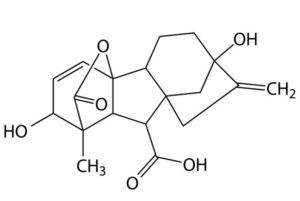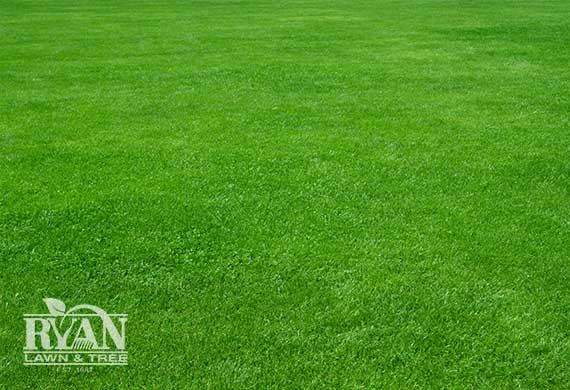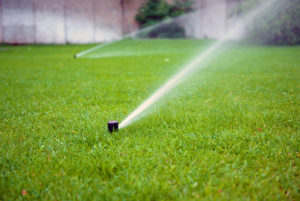What is a Lawn Growth Regulator?
The short answer is that a growth regulator slows down the vertical growth of a plant or turf while encouraging it to stick together and grow denser. Applying one saves time and reduces the amount of maintenance required while improving the plant’s appearance and quality. If you think your lawn may need regulation, there is plenty of information below that summarizes the technical details, and should make your decision to use one easier.

A RYAN growth regulator inhibits cell lengthening in plants, which slows the vertical growth in grass. This process allows turf to continue fighting off certain diseases, which helps contribute to a healthier lawn.
Plant Growth Regulator
A plant growth regulator is a natural or synthetic product that is designed to mimic hormones and compounds within plants in an effort to control a plant’s growth characteristics, either by promoting or suppressing growth. Plants require these compounds to control their growth just as much as they require water, light, and nutrients.
Growth regulators can suppress shoot growth, increase the formation of leaves and branches, or control the amount and maturity rate of flowering and fruit production. The effectiveness of the applied compound depends upon the dosage used and how well it is absorbed by the plant. Other factors that contribute to good results include the age and health of the plant, the timing of the application, and the weather.
Turf Growth Regulator

Gibberellins are the growth regulators that contribute to and influence a plants developmental process, such as: germination, stem elongation, flowering, etc.
A turf growth regulator works by inhibiting gibberellin biosynthesis. Gibberellin is a hormone needed for cell elongation and other development processes like shoot growth and dormancy. Limiting gibberellin production in turf will slow the grass’ vertical growth and keep it short. The turf growth regulator is quickly absorbed by the grass blades and is immediately rain fast, meaning it won’t wash off grass blades easily.
Benefits of Using a Growth Regulator
Although saving yourself time and effort is the main advantage of a growth regulator, there are a few other advantages offered if you choose to use one:
- A Turf Growth Regulator (TGR) is a product that is applied to lawns to slow the growth of the grass blades. By slowing them down, you can reduce the number of clippings every time you mow. This limits the number of times you need to bag the mowed grass, along with the amount of yard waste produced. The duration of a regulator’s effects varies from application to application. The typical length is between four and seven weeks, depending on the grass species and other environmental and growth factors.
- Slowing the growth of the grass blades concentrates the amount of chlorophyll contained in each blade. This can give the grass a slightly darker green color.
- A Plant Growth Regulator (PGR) slows the grass blade growth, but it does not slow the root or tillering growth. So the shorter, darker green blades will continue to produce large amounts of carbohydrates for the roots, creating a deeper, stronger root system. The extra carbohydrates allow the grass to produce more tillers so the lawn as a whole becomes thicker and denser.
The shorter stronger blades will lower ET (evapotranspiration) rates. But the deeper stronger roots will not change ET rates. It allows the grass plant to “tap” into more water deeper in the soil and survive heat and drought stress longer. So coupling the slightly lower ET rates due to slower growing and stronger blades with deeper root system, helps the grass avoid heat/drought stress better than an unregulated grass plant.
- Hot temperatures in summer often stresses turf and leaves it looking unhealthy as it struggles to combat harsher conditions. Growth regulators allow the turf to conserve energy at the roots and keep the plant in better condition. This means that the turf more easily withstands stress and disease and keeps its lush, green appearance.
Using a growth regular is an excellent way to get a gorgeous lawn that is easy to care for.
A Growth Regulator Is Not a Weed or Disease Control

Since a Growth Regulator slows lawn growth rates, you must adjust your mowing schedule to compensate. When mowing your lawn, you should follow the one-third rule, which means you should not remove more than one-third of the leaf tissue when you mow. If you are trying to grow grass at two inches high, don’t let it grow taller than three inches before mowing or trimming. Or, if you are growing tall fescue at three inches high, don’t let it grow taller than four and a half inches before you mow, and so on.
During the springtime when the grass is growing very rapidly, you might have to mow your lawn every three to five days to ensure the clippings are under that one-third rule and that they are easily dispersed back onto the lawn. Unfortunately, most homeowners don’t have the time or ability to mow more than once a week, which is where a PGR comes in. Applying a PGR means you can relax your mowing schedule slightly, though it is still recommended that you mow once every week.
A PGR application makes it easier to manage lawn clippings when mowing. If you can, you should recycle your clippings back into the lawn, which will save you time, reduce clipping waste, and help keep your lawn looking tidy and vibrant.
Turf Growth Regulator Application
A standard TGR application will create shorter, darker green grass blades and will also make the lawn thicker and denser with deeper roots. It will help the lawn use less water and its effects last about four to seven weeks, depending upon the weather. It should be noted that warmer weather shortens the effects. You should notice a significant reduction in clipping yield after you mow next.

Yards that have been treated with a lawn growth regulator look greener, thicker, and healthier.
The application process is simple but requires you to follow a few recommendations to achieve the desired results. Most PGRs compounds are mixed with water and added to a hand-held sprayer. Boom sprayers or a professional application might be best for larger areas. While you can apply the PGR yourself with a handheld sprayer, application accuracy and uniformity is a must. And this application is best left to professionals with professional equipment. Always follow the instructions on your selected product.
Like most lawn applications, pets and people are free to use the lawn without worry once the product has dried on the grass blades.
Only the plants that are directly sprayed with the growth regulator will be affected. Make sure you apply an even application to the entire desired area to avoid uneven grass growth. It’s best to spray on a calm day when there is no wind to interfere and blow the mixture onto other plants.
Timing is another important factor to consider. Spray PGRs on healthy turf and plants before harsh seasonal conditions diminish their strength and energy reserves. Make certain to check your lawn for damage before applying a PGR. If you detect any damage from insects or diseases, correct the issue before applying the compound. Slowing the growth of an unhealthy plant makes it more difficult for it to recover.
Plant and turf growth regulators can be used on your lawn, trees and shrubs, and other ornamental plants. Applications should be used only on healthy plants for the best results. PGR compounds support the root structure of plants while controlling the amount of growth, so you can limit the maintenance required to get a healthy and beautiful lawn.
Do You Need Some Help With a Lawn Mowing Reducer Treatment?
We hope you enjoyed this post about the many benefits of using a growth regulator on your lawn. If mowing less and improving your lawns overall health is music to your ears, RYAN is always here to help!
Get a Free Estimate today for help with your lawn growth regulator treatment needs by a RYAN lawn care expert!

 The shorter stronger blades will lower ET (evapotranspiration) rates. But the deeper stronger roots will not change ET rates. It allows the grass plant to “tap” into more water deeper in the soil and survive heat and drought stress longer. So coupling the slightly lower ET rates due to slower growing and stronger blades with deeper root system, helps the grass avoid heat/drought stress better than an unregulated grass plant.
The shorter stronger blades will lower ET (evapotranspiration) rates. But the deeper stronger roots will not change ET rates. It allows the grass plant to “tap” into more water deeper in the soil and survive heat and drought stress longer. So coupling the slightly lower ET rates due to slower growing and stronger blades with deeper root system, helps the grass avoid heat/drought stress better than an unregulated grass plant.








